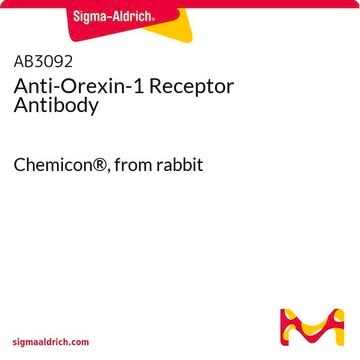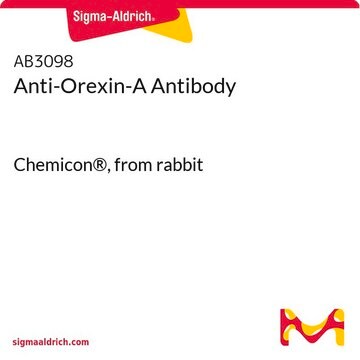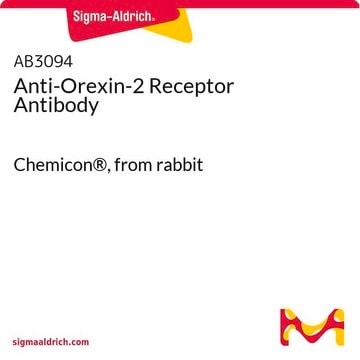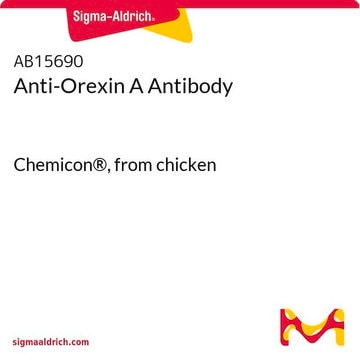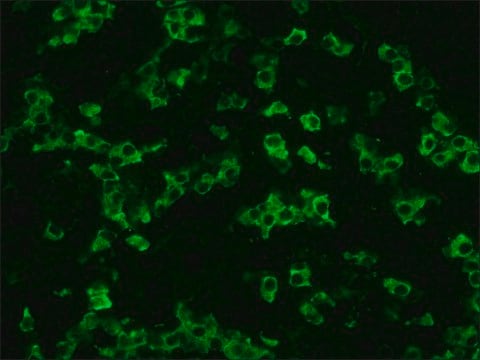General description
Orexin (UniProt O43612; also known as Hcrt, Hypocretin) is encoded by the HCRT (also known as NRCLP1, OX, PPORX, and PPOX) gene (Gene ID 3060) in human. Orexins are highly conserved excitatory neuropeptides that serve as endogenous ligands for an orphan G-protein-coupled receptor (GPCR) and play a significant role in the regulation of food intake and sleep-wakefulness cycle. Orexin-A and -B are derived from the same precursor peptide (prepro-orexin) by proteolytic processing. They exhibit about 50% sequence identity. Orexin-A consists of 33 amino acid residues with two intra-chain disulfide bonds and orexin-B consists of a linear chain of 28 amino acids. They bind and activate two closely related GPCRs, termed OX1 and OX2 receptors. OX1 appears to be selective for orexin-A, whereas OX2 is a nonselective receptor and binds both orexin-A and -B. Orexins are predominantly localized in neurons located in the lateral hypothalamic area, a region implicated in feeding behavior. However, orexin-containing neurons diffusely innervate the entire brain, including monosynaptic projections, to various regions of the cerebral cortex, limbic system, and brain stem. Deficiency of orexin is reported to be a causative factor in human narcolepsy. Ref.: Martynska, L., et al. (2005). Neuroendocrinol. Lett. 26(4):289-292
Specificity
Clone 3H9.3 epitope resides within the propeptide sequence and will detect prepro- and pro-orexin, but not mature orexin, orexin A, or orexin B.
Immunogen
GST-tagged recombinant human orexin fragment composed of orexin-B and the propeptide region sequence.
Application
Anti-pro-Orexin, clone 3H9.3, Cat. No. MABN1526, is a highly specific mouse monoclonal antibody that targets pro-orexin and has been tested in Immunohistochemistry (Paraffin) and Western Blotting.
Immunohistochemistry Analysis: A 1:50 dilution from a representative lot detected pro-orexin immunoreactivity in human and rat brain tissue sections.
Research Category
Neuroscience
Quality
Evaluated by Western Blotting in human thalamus tissue lysate.
Western Blotting Analysis: A 1:1,000 dilution of this antibody detected pro-orexin in 10 µg of human thalamus tissue lysate.
Target description
~17 kDa observed. Target band size appears larger than the calculated molecular weights of 13.36/10.03/6.806 kDa (Prepro-/Pro-/mature Orexin) due to glycosylation. Uncharacterized bands may be observed in some lysate(s).
Physical form
Format: Purified
Protein G purified.
Purified mouse IgG2aκ in buffer containing 0.1 M Tris-Glycine (pH 7.4), 150 mM NaCl with 0.05% sodium azide.
Storage and Stability
Stable for 1 year at 2-8°C from date of receipt.
Other Notes
Concentration: Please refer to lot specific datasheet.
Disclaimer
Unless otherwise stated in our catalog or other company documentation accompanying the product(s), our products are intended for research use only and are not to be used for any other purpose, which includes but is not limited to, unauthorized commercial uses, in vitro diagnostic uses, ex vivo or in vivo therapeutic uses or any type of consumption or application to humans or animals.


